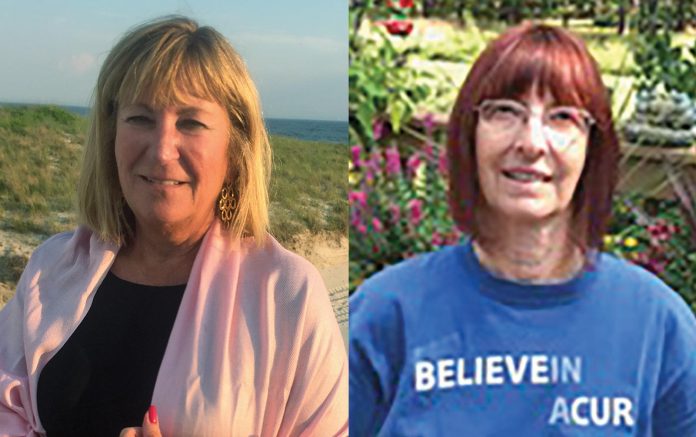By Jennifer Byrne
Posted: August 19, 2020
For nearly 2 decades, Bonnie Anderson has defied incredible odds in the face of mesothelioma, hairy cell leukemia, breast cancer, lung cancer, and kidney cancer.
“Since they can’t do anything about the mesothelioma or the kidneys or any of the tumors, I’m pretty much out of options until somebody comes up with something good,” Ms. Anderson said in an interview with IASLC Lung Cancer News (ILCN). “But I’m still here. The doctors gave me 6 months, and here I am, 18 years later.”
Ms. Anderson may not know exactly what her future holds, but there’s one thing she does know: she hasn’t fought this hard only to expose herself to COVID-19. “I’ve stayed alive all this time, and this kind of virus would kill me,” Ms. Anderson said. “I’m scared. I really am scared. I just got over pneumonia this past summer and that was bad enough. I can’t imagine what having this virus is like.”
Like many cancer survivors and patients, Ms. Anderson, who is followed regularly for her various conditions, found her way to telehealth through simple necessity. “It wasn’t something that was an emergency or unforeseen,” she explained. “It was my 6 months’ follow-up and I couldn’t get into the office and they weren’t in the office, so we said, ‘let’s do this over Zoom or FaceTime.’ And it worked out quite well.”
For cancer survivors and patients, telehealth has represented a possibility for receiving ongoing care from top-quality cancer centers despite geographic obstacles, time constraints, and patient vulnerability or risk. However, telehealth truly began to flourish in the United States only recently, when the COVID-19 pandemic made it a matter of life or death.
Emotional Reassurance From Physical Touch
When a biopsy revealed that Laura Shanahan had pleural mesothelioma, one of the first things she did was seek treatment from Memorial Sloan-Kettering Cancer Center in New York City.
“They have a specialist unit that deals with mesothelioma, and they have clinical trials and great, experienced doctors,” she said. “My disease was inoperable, and so the doctor suggested that I do the standard chemotherapy regimen, and then look to participate in a trial for CAR T-cell therapy. With six chemotherapy treatments, the CAR T-cell trial, and now being on pembrolizumab every 3 weeks since the trial, my cancer is considered stable at this point.”
A resident of Long Island, Ms. Shanahan has generally had no difficulties getting to her follow-up appointments at Memorial Sloan Kettering; in some cases, she has felt well enough to take mass transportation. However, like Ms. Anderson, Ms. Shanahan had serious concerns risking exposure to COVID-19.
“I really did not feel comfortable going into Manhattan,” Ms. Shanahan told ILCN. “I would have driven in, and I’m sure the hospital is sterile, but I was really hoping my doctor would allow me to get the treatments out of their facility in Uniondale, which is about 10 minutes from where I live.”
Ms. Shanahan’s clinician agreed to this plan, and also offered teleconferencing appointments. Her current regimen is to have her bloodwork and her pembrolizumab treatments administered at the Uniondale facility, and to teleconference her appointments with her oncologist.
“The process was very easy—the links the hospitals sent worked, and I had no issues with the technology,” Ms. Shanahan noted. “The doctor asked me how I was feeling, reviewed my test results. The only thing that was missing was the physical exam.”
Similarly, Ms. Anderson also viewed the lack of physical exam as the primary drawback to telehealth visits for cancer care. She said that although she can conduct some aspects of the exam— including blood pressure, temperature, and weight measurements—on her own, there are other factors she’d prefer to have assessed by a trained eye.
“Sometimes the doctor will feel the glands in my neck and feel something I’m not feeling,” she said. “Or I can tell when I’m wheezing, and I can hear that little noise in my lungs, but there are sometimes other noises in my lungs that I don’t hear that the doctor picks up on. Or with breast self-exams, I’m not sure I would notice something in its early stages, whereas I feel very comfortable with my doctor and their knowledge through touch.”
These are among the temporary adjustments Ms. Anderson has had to make to minimize her risk of COVID-19 exposure. She also deferred her bloodwork for her lung disease by one month, not wanting to visit a local lab in April. “I haven’t even been going to the grocery store—my husband is doing that,” she said.
Ms. Shanahan said she would be open to telehealth after the pandemic is over but added that she could see a mix of the two types of visits. “I think telehealth is great when you’re discussing test results or treatment options. But I do think there is a certain need, with my condition, to be able to have a physical examination.” Ms. Anderson, who also said she would be willing to do telehealth visits after the pandemic is over, depending on the nature of the visit, added that she would consider it beneficial for patients to get a detailed transcript of their visit, including the physician’s instructions. ✦
Related Article:
Telehealth Successes and Challenges











